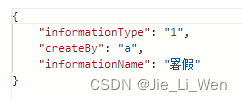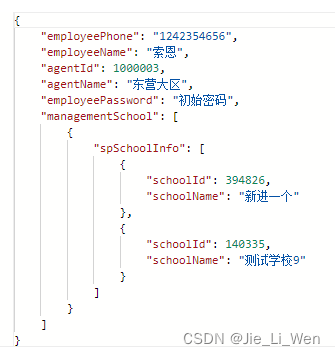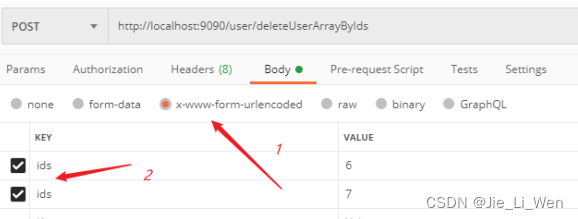传参是字符串集合:list
当使用getMapping()时,使用@requestParam("strs") List<String> strs

ApiPost

还有一种写法:

当使用PostMapping()时,使用requestBody

APIPost

即:

如果是List<Integer>

详细说一下:


如果使用requestParam 注意
@RequestParam
里的
value
一定要带上中括号:




或者

传参是字符串集合Map:

ApiPost

多种情况:
传参在路径上


拼接传参

这里之所以这么复杂,是因为还上传了文件格式,如果不需要上传文件,直接包装成requestBody
即如下:

@RequestBody
一般用来处理Content-Type:"application/json,application/xml"两种格式的请求,能够将传过来的参数自动封装成指定类上。
但是文件上传Content-Type不是这个,所以两者只能求同不能存异。
@RequestParam
通过注解@RequestParam可以轻松的将URL中的参数绑定到处理函数方法的变量中。
v1/list?page=1&pageSize=1@PathVariable
通过 @PathVariable 可以将 URL 中占位符参数绑定到控制器处理方法的入参中:URL 中的 {xxx} 占位符可以通过@PathVariable(“xxx”) 绑定到操作方法的入参中。
v1/info/{roomId}@Param
作用与dao层,把方法中的传参映射到sql中。
@Mapper public interface UserMapper { Integer insert(@Param("username") String username, @Param("address") String address); }对于xml文件如下:
insert into user (username,address) values (#{username},#{address});
ApiPost
参数格式:

参数:数组类型 Integer[] ids


另一种(这两种都没试,我用的requestbody)
后台接收数组

运行代码:


版权归原作者 Jie_Li_Wen 所有, 如有侵权,请联系我们删除。